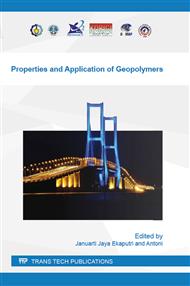p.140
p.148
p.157
p.162
p.170
p.178
p.186
p.193
p.200
Oil Palm Clinker Potentility for Producing Lightweight Concrete: Compressive Strength, Tensile and Modulus of Elasticity Analysis
Abstract:
Oil palm clinker is formed by burning of oil palm kernel shell and fibrous materials in boiler furnace. The clinker is no longer a bio-material that has changed to inert material likes the crushed brick. Large quantities oil palm clinkers have become a waste and caused disposal problem. It requires extra costs for handling, transportation and finding out suitable the dumping site. Research has been conducted to explore the potentiality usage of oil palm clinker as fine and coarse lightweight aggregates at Universiti Pertanian Malaysia. Mixtures of oil palm clinker concretes were designed, prepared and tested. Mechanical properties of a good mixture of tensile strength, compressive strength, modulus of elasticity, creep and shrinkage were satisfied the standard engineering codes of practices. Oil palm clicker concrete was found lighter than conventional concrete, which usually weighs between 2240 and 2400 kg m-3. The means of compressive and tensile strengths were found 30.79 and 3.34 N mm-2 respectively. In addition, the mean of modulus of elasticity was 13.024 kNmm-2. Therefore, oil palm clinker aggregate and concrete are recommended to be used in lightweight reinforced concrete structures.
Info:
Periodical:
Pages:
200-209
Citation:
Online since:
January 2016
Price:
Сopyright:
© 2016 Trans Tech Publications Ltd. All Rights Reserved
Share:
Citation:


